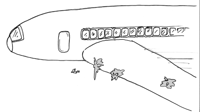STRANGE BUT TRUE- Large snarge: Why snakes and rabbits hit airplanes

DRAWING BY DEBORAH DERR McCLINTOCK
Q. What is "snarge,"and how are the good folks at the Smithsonian Institution's Feather Identification Laboratory working to make your next plane flight safer? –S. Sullenberger
A. Believe it or not, snarge is the bird goo left over from a collision with an airplane. And it's not just birds.
"We've had frogs, turtles, snakes, even a cat once struck at high altitudes," says the Smithsonian's Carla Dove. Birds like hawks and herons will occasionally drop their quarry into oncoming planes.
Recently, she sent a "snake" sample to the DNA lab, and it came back as rabbit.
"How do you explain to the Federal Aviation Administration (FAA) that we had a rabbit strike at 1,000 feet?" Dove asks.
It's of intense interest to both the FAA and the U.S. military to know what kinds of birds are smacking into the nation's airplanes. At the lab, technicians identify the snarge DNA, then enter the sequence into a national database.
Although most cases consist of feathers, many consist of a "paper towel swipe" of gooey bird fat, flesh bits, spores. Once the type of bird is identified, steps can be taken to avert future incidents, such as by altering flight paths and by engineering more bird-resistant planes.
As an example, jet engines must now be able to withstand the ingestion of an eight-pound waterfowl. "Of course, we're trying to improve aviation safety," says Dove, "but we're also helping to save the birds."
Q. Does lightning ever strike twice in the same place in the sense of successive holes-in-one struck by the same golfer? How about thrice? –J. Frost
A. Most remarkable was the performance of Norman Manley, who holed the seventh (330 yards) and eighth (290 yards) at California's Del Valle Country Club in 1964, says John Wesson in The Science of Golf. The thrice was achieved by Bob Taylor in 1974 on the Hunstanton Links course at Norfolk, England. He holed the 188-yard 16th-hole from the tee on the practice day of the competition, then did the same on both day 1 and day 2 of the competition proper– three successive holes-in-one on the same hole!
Record for the longest hole-in-one is tougher to assign, due to different conditions such as dog-legs and favorable slopes.
But longest success on a straight hole was in Omaha, Nebraska, in 1965 when Bob Mitera holed a 447-yard drive— helped, however, by a downhill slope. This record held until 2007 when Bret Melson aced the 448-yard, par 4 at the Ko'olau Golf Club in Oahu, Hawaii, "edging out Mitera by a massive one yard"!
Q. It's hard to sell the valiant human spirit short, especially when that spirit yearns to communicate under the most difficult of circumstances, such as the spirit of French journalist Jean-Dominique Bauby, who wrote the book The Diving Bell and the Butterfly, on which the movie was based. Explained one New York critic: The lightness of the butterfly symbolizes the persistence of Bauby's spirit, the heaviness of the bell his extreme physical difficulties. What difficulties? –S. Hawking
A. Bauby himself composed and dictated his memoir recounting the massive stroke that left him in a state known as "locked-in syndrome," mentally alert but deprived of speech and of all movement except for control of his left eyelid, says William Hanson in The Edge of Medicine.
Bauby painstakingly "wrote" by blinking his eyelid to select each letter as an assistant ran through a frequency-ordered alphabet and came to the correct letter.
He dictated the slim volume in the summer of 1996, averaging only a single word every two minutes. The following spring, ten days after the highly successful publication of his book, Bauby died.
Q. Folklore says lightning seeks out oak trees, and, surprisingly, a high percentage of trees shattered are oaks. So how does lightning pick them out from all the rest? –B. Franklin
A. Oaks aren't hit more, but their rough bark traps rainwater and keeps the lower trunk dry, especially early in a storm, says Jearl Walker in Flying Circus of Physics.
Smooth-barked trees get drenched faster, top to bottom, so the lightning descends harmlessly through the water sheath into the ground. For oaks, the current more often enters the tree, heats the sap and blows the trunk apart.
~
Send strange questions to brothers Bill and Rich at [email protected].
#